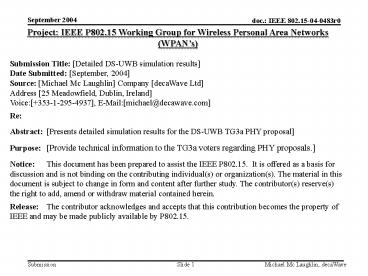Detailed simulation results for the DSUWB PHY proposal - PowerPoint PPT Presentation
1 / 54
Title:
Detailed simulation results for the DSUWB PHY proposal
Description:
The material in this document is subject to change in form and content after further study. ... No DFE used for rates below 110 Mbps. 1.9dB Tx power backoff at ... – PowerPoint PPT presentation
Number of Views:45
Avg rating:3.0/5.0
Title: Detailed simulation results for the DSUWB PHY proposal
1
Project IEEE P802.15 Working Group for Wireless
Personal Area Networks (WPANs) Submission
Title Detailed DS-UWB simulation results Date
Submitted September, 2004 Source Michael Mc
Laughlin Company decaWave Ltd Address 25
Meadowfield, Dublin, Ireland Voice353-1-295-49
37, E-Mailmichael_at_decawave.com Re
Abstract Presents detailed simulation results
for the DS-UWB TG3a PHY proposal Purpose Provid
e technical information to the TG3a voters
regarding PHY proposals. Notice This document
has been prepared to assist the IEEE P802.15. It
is offered as a basis for discussion and is not
binding on the contributing individual(s) or
organization(s). The material in this document is
subject to change in form and content after
further study. The contributor(s) reserve(s) the
right to add, amend or withdraw material
contained herein. Release The contributor
acknowledges and accepts that this contribution
becomes the property of IEEE and may be made
publicly available by P802.15.
2
Simulation Overview
- AWGN and channel models CM1 to CM4
- Bit rates range from 9Mbps to 1.32Gbps
- Fully impaired Monte Carlo Simulation
- rake coefficients quantized to 3-bits
- 3-bit A to D converter (I and Q channels)
- RRC pulse shaping
- DFE trained in lt 5?s in noisy channel (for
bitrates gt55Mbps) - Front-end filter for Tx/Rx 6.6 dB Noise Figure
- Packet loss due to acquisition failure
3
Simulation parameters
- 16 rake taps for 110Mbps and greater
- k6 convolutional code (k4 for 990Mbps)
- Usually 8 rake taps for rates below 110Mbps
- Low complexity simulations of 2 rake taps at
9Mbps - 31 Tap DFE for 110Mbps and greater
- No DFE used for rates below 110 Mbps
- 1.9dB Tx power backoff at 9Mbps to allow for
ripple
4
Awgn Range for 110Mbps
5
CM1 Range for 110 Mbps
6
CM2 Range for 110 Mbps
7
CM3 Range for 110 Mbps
8
CM4 Range for 110 Mbps
9
AWGN range for 220 Mbps
10
CM1 range for 220 Mbps
11
CM2 range for 220 Mbps
12
CM3 range for 220 Mbps
13
CM4 range for 220 Mbps
14
Range for 110 and 220 Mbps
15
Range for 110 and 220 Mbps
16
90 Outage ComparisonMandatory Rates
17
Range for 500 and 660 Mbps
18
Range for 500 and 660 Mbps
19
90 Outage ComparisonHigh Rates
20
Miscellaneous Rates
21
Miscellaneous Modes
22
Ultra High Rates1Gbps and 1.33Gbps
23
AWGN range for 1Gbps
24
CM1 range for 1Gbps
25
CM1 range for 1Gbps 85 outage
26
CM1 range for 1Gbps 80 outage
27
CM1 range for 1Gbps 70 outage
28
AWGN range for 1.33Gbps
29
Ultra High Rates
30
Common Signalling Mode Rates
31
Range for CSM modes
32
Range for CSM modes
33
Backup Slidesthe following slides contain
graphs of the data from which the ranges forthe
various bit rates were obtained
34
AWGN range for 330Mbps
35
CM1 range for 330Mbps
36
CM2 range for 330Mbps
37
AWGN range for 663Mbps with no coding
38
AWGN range for 1Gbps
39
AWGN range for 500Mbps
40
CM1 range for 500Mbps
41
CM2 range for 500Mbps
42
AWGN range for 660 Mbps with coding
43
CM1 range for 660Mbps
44
CM2 range for 660Mbps
45
AWGN range for CSM at 9Mbps
46
CM1 range for CSM at 9Mbps
47
CM2 range for CSM at 9Mbps
48
CM3 range for CSM at 9Mbps
49
Low complexity (2 rake taps) CSM at 9Mbps over
CM1
50
Low complexity (2 rake taps) CSM at 9Mbps over
CM2
51
AWGN range for CSM at 110Mbps
52
CM1 range for CSM at 110Mbps
53
CM2 range for CSM at 110Mbps
54
CM3 range for CSM at 110Mbps































